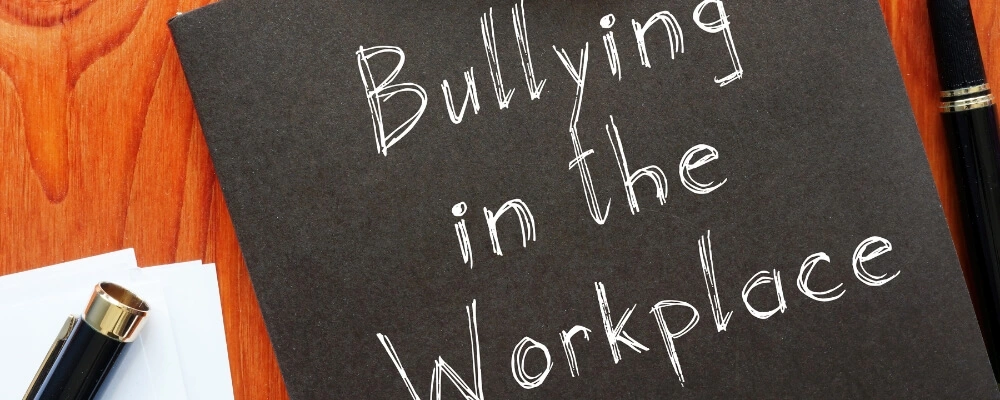In today’s rapidly evolving professional landscape, maintaining a healthy work environment is not just a perk—it’s a necessity. Amid the multitude of challenges faced by businesses, one issue that often slips through the cracks, but carries significant ramifications, is workplace bullying. This silent epidemic can undermine an organization’s very foundation, leading to decreased morale, reduced productivity, and high turnover rates. This comprehensive guide aims to shed light on the subtle and overt manifestations of workplace bullying.
By understanding its definition, recognizing its examples, and implementing concrete solutions, employers and employees can create a workspace that thrives on mutual respect, cooperation, and positive engagement. Dive in to equip yourself with the knowledge and tools needed to combat and prevent bullying in your professional environment.
What is Workplace Bullying? Definition
Workplace Bullying is defined as repeated, unwelcome behavior directed towards an individual or a group of employees that is intended to degrade, intimidate, humiliate, or undermine; or which creates a risk to the health and safety of the targeted individuals. It can be overt, like shouting and threats, or more subtle, such as spreading malicious rumors or isolating someone from a group.
The intent is to hurt or isolate the person psychologically and, in some cases, physically. Such behavior, especially when persistent, can create an environment of fear, distrust, and anxiety, ultimately affecting the well-being and performance of employees and the organization at large.

Different Examples Of Bullying In The Workplace
Workplace bullying can manifest in various ways, both overt and subtle. Here are different examples of bullying in the workplace:
1. Verbal Abuse
Verbal workplace abuse refers to using words and language to undermine, belittle, or harm an employee. Belittling or demeaning comments can erode an individual’s self-worth, making them doubt their capabilities and value. When a supervisor or colleague yells or shouts inappropriately, it creates an atmosphere of fear and intimidation. Such acts not only humiliate the recipient in front of peers but can also negatively impact their mental health.
Making malicious remarks, insults, or name-calling is unprofessional and can deeply hurt someone, affecting their emotional well-being and performance. Furthermore, spreading unfounded rumors or gossip can tarnish an individual’s reputation, leading to mistrust, alienation, and severe stress.
2. Isolation/Exclusion
Isolation or exclusion strategies are manipulative ways to ostracize an individual from the group. When someone is deliberately excluded from meetings or social gatherings, they may feel left out, undervalued, or even suspect that discussions detrimental to their position are occurring.
Ignoring or avoiding someone without a valid reason can significantly affect their confidence and motivation. Such behavior can make the affected individual feel invisible or isolated, leading to emotional distress and disengagement from work.
3. Undermining Work
Undermining an individual’s work is a tactic to belittle their contributions and shake their confidence. Constantly criticizing someone’s work without justification can cause anxiety, reduce productivity, and decrease job satisfaction. Withholding crucial information that a person needs to perform their role can set them up for failure, further eroding their confidence.
Sabotaging an individual’s efforts by providing incorrect instructions or setting impossible deadlines can lead to frustration and burnout. Moreover, taking credit for someone else’s work is unethical and can demoralize the contributor, making them feel exploited and undervalued.
4. Manipulation of Work Role
Tampering with a person’s work role can cause confusion, lower morale, and diminish a sense of purpose. Assigning menial or demeaning tasks outside one’s job description can degrade and demotivate an employee.
Changing job guidelines or roles frequently can disorient workers, leading to inefficiency and dissatisfaction. Similarly, removing areas of responsibility without a valid reason can make an individual feel undervalued or redundant.
5. Sabotage
Sabotage is a malicious act to hinder or harm an employee’s performance. Deliberately tampering with someone’s work, equipment, or resources can lead to mistakes, rework, or even dangerous situations. Stealing or hiding essential supplies and tools can prevent an employee from completing tasks while falsifying or manipulating work records can unjustly tarnish their reputation or lead to unwarranted disciplinary actions.

6. Threats or Intimidation
Threats and intimidation create a hostile work environment. Making groundless threats about job security can induce anxiety and uncertainty. Physical threats or aggressive gestures can endanger the safety and well-being of employees. Intimidating remarks or behavior can suppress open communication and create an atmosphere of fear and mistrust.
7. Intrusion
Intrusion into an individual’s personal space or information breaches trust and privacy. Pestering, spying, or stalking an employee can lead to severe stress and vulnerability. Inappropriately accessing personal or work emails can lead to the misuse of sensitive information, causing harm to the individual or the organization.
8. Unreasonable Work Demands
Overloading an individual with work can lead to burnout, decreased quality of work, and health issues. Setting unachievable deadlines can create undue stress while assigning tasks well below an employee’s skill level can result in boredom, frustration, and a diminished sense of purpose.
9. Unwarranted Punishment
Administering undeserved or excessive formal warnings can demotivate and intimidate an employee. It can also tarnish their professional record, affecting future opportunities. Harsh penalties for minor offenses can seem unfair, leading to resentment and decreased morale.
10. Personal Attacks
Making fun of someone’s personal traits, beliefs, or life outside work is deeply disrespectful and can harm an individual’s self-esteem. Making offensive comments about one’s gender, race, religion, or other protected attributes is morally wrong and can lead to legal repercussions for the organization. Such remarks create a toxic environment that hinders collaboration, trust, and productivity.

How Can Bullying Affect An Individual?
Bullying can have profound and long-lasting effects on an individual. Its impact extends beyond immediate victimization and can infiltrate various facets of a person’s life. Here’s how bullying can affect an individual:
- Emotional and Psychological Impact: One of the most immediate and apparent effects of bullying is the emotional and psychological toll it takes. Victims often experience heightened feelings of sadness, loneliness, and depression. Over time, these feelings can become chronic, leading to more severe psychological disorders.
- Decreased Self-Esteem: Victims often internalize the negative messages from bullies, leading to feelings of worthlessness, self-doubt, and a reduced sense of self-worth. They may start to believe they deserve the treatment they are receiving.
- Trust Issues: After experiencing bullying, an individual may find it challenging to trust others. This mistrust can affect personal relationships, hindering the ability to form or maintain new bonds.
- Physical Symptoms: Chronic stress and anxiety from bullying can manifest in various physical symptoms, such as headaches, stomachaches, fatigue, and sleep disturbances. Over time, these symptoms can lead to more significant health issues, including cardiovascular problems.
- Isolation: Victims might isolate themselves to avoid bullying and withdraw from social activities and interactions. This self-imposed isolation can exacerbate feelings of loneliness and depression.
- Performance Decline: For students or working professionals, bullying can lead to a noticeable drop in performance. Concentration can be hampered, and motivation to participate and excel can wane.
- Increased Risk of Substance Abuse: Some victims may turn to alcohol, drugs, or other substances as a coping mechanism, leading to addiction and other associated health risks.
- Anxiety and Panic Attacks: Persistent bullying can lead to heightened anxiety levels, with some individuals experiencing panic attacks characterized by rapid heartbeat, shortness of breath, and intense fear or discomfort.
- Post-Traumatic Stress Disorder (PTSD): In extreme cases, individuals who experience severe or prolonged bullying can show symptoms of PTSD, usually associated with severe trauma. These symptoms can include flashbacks, nightmares, and severe anxiety.
- Suicidal Ideation and Behavior: Tragically, some individuals who are relentlessly bullied contemplate or even attempt suicide. The hopelessness and despair can become so overwhelming that they see no way out.
Given the significant and diverse effects of bullying on an individual, institutions, workplaces, communities, and families must recognize the signs and intervene early. Providing support to victims, whether through counseling, therapy, or other means, can be crucial in helping them recover and heal.

How Can Bullying Affect The Workplace?
Bullying in the workplace not only affects individual employees but also has widespread consequences for the organization as a whole. Here’s how bullying can impact the workplace:
- Reduced Productivity: Employees who witness bullying often become demotivated and distracted. This leads to decreased work output and quality, affecting overall productivity.
- Increased Absenteeism: Victims of bullying may take more days off to recover from the emotional and psychological effects or to avoid confrontations. This absenteeism can disrupt operations, result in delays, and lead to unmet targets.
- High Turnover: An environment plagued by bullying can lead to increased staff turnover as employees leave to find safer work environments. High turnover is costly regarding recruitment, training, and the loss of experienced staff.
- Decreased Morale: Bullying creates a toxic work environment, reducing the team’s morale. An atmosphere of fear, mistrust, and resentment can permeate the organization.
- Legal Consequences: Companies may face legal challenges if bullying leads to violations of workplace laws or if they fail to address reported incidents. Lawsuits can be costly financially and in terms of the organization’s reputation.
- Reputation Damage: Word about bullying can spread beyond the confines of the organization. A company known for bullying can struggle to attract top talent and may face negative public perception, affecting stakeholder relationships and customer trust.
- Increased Costs: Companies may face increased operational costs due to the repercussions of bullying. This can include the costs of employee assistance programs, conflict resolution initiatives, legal proceedings, recruitment efforts, and even potential compensation to affected employees.
- Reduced Innovation and Collaboration: Fearful employees are less likely to voice their ideas, concerns, or feedback, leading to a stifling of innovation. Moreover, lacking trust can hamper collaboration, which is vital for many projects and tasks.
- Impact on Bystanders: Those who witness bullying may also be affected, experiencing stress, fear, or guilt. This can further erode the sense of team cohesion and camaraderie.
- Training and Developmental Setbacks: In a bullying environment, rather than focusing on growth and development, organizational resources might be diverted toward conflict resolution, counseling, and managing the consequences of bullying.
Considering the detrimental effects of bullying on the workplace, it’s vital for organizations to actively foster a positive, respectful, and inclusive work environment. This involves implementing comprehensive anti-bullying policies, promoting awareness and training, and ensuring that reported incidents are addressed promptly and effectively.

How to Prevent From Workplace Bullying In The Workplace
Preventing workplace bullying is crucial for maintaining a healthy and productive work environment. Here are some steps you can take to prevent workplace bullying:
1. Foster Respect
The foundation for positive interactions and relationships in every organization lies in mutual respect. Encouraging a culture of respect and kindness means promoting a work environment where each person’s opinions, ideas, and personal boundaries are acknowledged and honored. This extends beyond simple courtesy—it involves recognizing that every member, irrespective of rank or tenure, plays a crucial role in the organization’s success. When respect becomes an intrinsic part of the workplace culture, employees feel valued and understood, leading to better collaboration and reduced potential for conflicts.
2. Clear Anti-Bullying Policies
Setting explicit boundaries for acceptable behavior is essential. By having a well-communicated zero-tolerance policy against bullying, companies affirm their commitment to a safe and inclusive workspace. This policy should not merely be a document but should be regularly discussed in team meetings, highlighted during onboarding processes, and easily accessible. Employees should be fully aware of what constitutes bullying and, more importantly, the repercussions such behavior will entail, ensuring accountability at all levels.
3. Open Lines of Communication
A workplace where employees can voice their concerns without fear is pivotal in preventing bullying. Open lines of communication, such as an open-door policy, reassure employees that their concerns are valid and will be addressed. It not only helps in the early detection of potential issues but also fosters a sense of belonging and trust within the team. Moreover, it emphasizes the value of positive and critical feedback in the growth of the organization and its members.
4. Provide Training
Regular training sessions can serve multiple purposes. They can educate employees about the subtle forms of bullying, help teams build better collaboration strategies, and offer tools for conflict resolution. By equipping employees with the knowledge and skills to handle interpersonal challenges, businesses can significantly reduce the instances and impacts of bullying. Additionally, these trainings reinforce the organization’s commitment to a harmonious work environment.
5. Lead by Example
Leadership plays an instrumental role in setting the tone for organizational behavior. When managers and leaders demonstrate respect, empathy, and fairness in their interactions, it sends a powerful message to the team about expected behaviors. Conversely, if leaders exhibit or tolerate bullying, it can implicitly endorse such behavior. Therefore, those in leadership positions must embody the values and principles they wish to see throughout their organization.
6. Encourage Reporting
The fear of retaliation or being labeled a “snitch” can often deter victims or witnesses from reporting bullying incidents. To combat this, companies should establish clear and confidential reporting mechanisms. Employees should be informed of these channels and reassured that their complaints will be treated with utmost confidentiality and urgency. The easier and safer it is to report, the more likely issues will come to light before they escalate.

7. Quickly Address Issues
Swift and decisive action in the face of reported bullying incidents serves a dual purpose. Firstly, it assists in immediately alleviating the situation for the victim, ensuring their safety and mental well-being. Secondly, it acts as a deterrent for potential bullies. When employees see that bullying complaints lead to real consequences, it reinforces the seriousness with which the organization views such behavior. This helps maintain trust in the reporting process and cements the organization’s commitment to a bully-free work environment.
8. Mediation
There are times when conflicts reach a point where resolution within the organization’s confines becomes challenging. In such cases, bringing in a neutral third-party mediator can be invaluable. Mediation offers a structured environment where parties can openly communicate their grievances and feelings. The mediator, who doesn’t have a stake in the outcome, can guide the conversation constructively, ensuring that each party is heard and working towards a mutually agreeable resolution.
9. Support for Victims
Experiencing bullying can have profound emotional and psychological effects. By offering services like counseling or employee assistance programs, organizations not only aid in the healing and recovery process of the affected individuals but also send a strong message about their commitment to employee well-being. Such support structures also emphasize the importance of mental health in the workplace, making employees feel valued and cared for.
10. Promote Team-building
A cohesive team is less likely to encounter internal conflicts. Team-building activities and workshops can play a crucial role in fostering a sense of camaraderie and mutual respect among team members. Through shared experiences and challenges, team members can better understand each other’s strengths, weaknesses, and perspectives, leading to better collaboration and reduced potential misunderstandings.
11. Regular Check-ins
A proactive approach to management often preempts issues before they escalate. By instituting regular check-ins or one-on-one meetings, managers can create an avenue for open dialogue with their team members. These sessions can serve as platforms for discussing performance, providing feedback, and most importantly, addressing any concerns or potential issues brewing beneath the surface.
12. Anonymous Feedback
Despite open-door policies and assurances of non-retaliation, some employees might still feel apprehensive about voicing their concerns openly. Anonymous feedback mechanisms, such as suggestion boxes or digital platforms, provide a safe space for these individuals to communicate their grievances or insights. This ensures that potential problems are highlighted, even if the person reporting them wishes to remain unidentified.

13. Stay Updated
The modern workplace is constantly evolving, shaped by factors like technological advancements, changing social norms, and global events. As such, strategies to combat bullying and ensure a positive work environment should also evolve. Organizations can adapt and refine their approaches by staying updated on the latest best practices, research, and expert recommendations, ensuring their work environment remains inclusive and harmonious.
14. Reinforce Positive Behavior
The behaviors that get recognized and rewarded are often those that get repeated. By celebrating and rewarding positive interactions, collaborations, and contributions to a harmonious work culture, organizations can motivate their employees to emulate these behaviors. Positive reinforcement not only boosts morale but also shifts the organizational culture towards one of mutual respect and collaboration. Recognizing acts of kindness, cooperation, and constructive communication encourages more of the same, making the workplace a more pleasant and productive space for everyone.
Conclusion
In the intricate tapestry of the workplace, each thread represents an individual, and the strength of the fabric lies in the harmony of its intertwined patterns. Bullying, however, frays this fabric, weakening not only individual strands but also the collective strength of the organization. Through our exploration, we’ve delved deep into understanding the multifaceted nature of this issue.
Recognizing its signs, manifestations, and implications is only the first step. The true journey begins with creating proactive solutions and fostering an environment where respect is paramount. For workplaces to thrive in this modern age, it is crucial to confront and address bullying head-on. By doing so, we not only enhance individual well-being but also fortify the resilience and success of our organizations. Remember, a harmonious workplace isn’t just a dream; with awareness, action, and commitment, it can be our reality.

